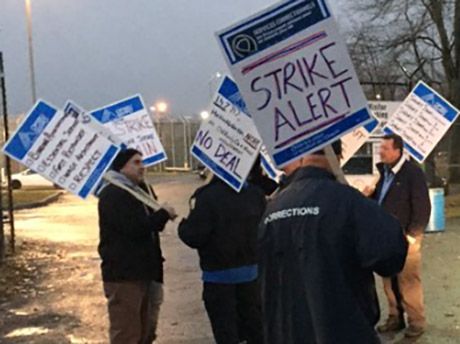Features
You are here
What will we strike for? Ontario Public Service ‘No’ campaign

November 13, 2015
After almost a year of bargaining, 34,000 OPSEU members who work directly for the government of Ontario ratified two contacts in October—but not without controversy.
The deals include the “central” collective agreement covering all OPSEU members working in the Ontario Public Service (OPS) and the agreement setting out wages and hours of work for almost 28,000 members in the “unified” bargaining unit. The 6,000 OPSEU members in the OPS correctional unit, who voted strongly against the central agreement, but have not reached a separate wages and hours agreement, could still go on strike.
When the tentative agreements were announced, two of the 15 bargaining team members sparked a major debate by speaking out against the deal and issuing a minority report calling for a “NO” vote. “Even though there are some good improvements in language in the central agreement,” the dissenters wrote, “the impact of the larger concessions causes too much harm to support. We believe that this contract will harm the sick and vulnerable and new workers the most. This supports Wynne’s race to the bottom mentality. Now is the time to protect workers in the OPS.”
This open dissent by bargaining team members, unprecedented in OPS bargaining history, sparked a “NO” vote campaign among a layer of members. Many who supported the NO position, including a strong majority in Corrections, demanded a more militant fight back against concessions. Supporting the deal was the majority of the bargaining team, who acknowledged the concessions but argued they were not severe enough to justify a strike.
Concessions in the new deal include a one year wage freeze and a two year freeze salary progression for new hires and those not at the top of their grids (for the unified unit); and ending accumulation of termination pay for future retirees, and a mandatory rehabilitation program for members on partial disability (across the OPS). This comes on top of concessions in the previous contract that included a two year wage freeze and a lower starting rate for new hires.
“No” advocates countered that it is time to fight back: “Young workers, new hires, and disability recipients are getting completely shafted in this deal and that's not something I could ever support. Even though I do not fall into one of those categories, I cannot in good conscious justify screwing over thousands of my OPSEU brothers and sisters in order to benefit myself and the majority of other OPSEU brothers and sisters. Sacrificing the few in order to protect the many is something I would expect from management, not from my union.”
Mobilize/Demobilize
The context for this round of bargaining was the vow by Liberal premier Kathleen Wynne to achieve “net zero” agreements across Ontario’s public sector. The Liberals’ austerity has also included ongoing downsizing of the OPS through the privatization and contracting out of thousands of OPSEU jobs.
OPSEU leaders strongly condemned Wynne’s austerity agenda. Members responded with a strong strike mandate: 90 pre cent average among the different sections of the OPS. This was backed up by member mobilizing that, similar to the fight against Hudak’s anti-union agenda, pushed deeper than usual into the rank-and-file.
Months of workplace meetings, information pickets and rallies focused on local member engagement over media photo-ops. Workers doggedly pursued Wynne at public events. Reports from mobilizers indicated that members were responding, including many who had never engaged actively in union activity. Despite this success, the leadership wound down the mobilization during the Pan Am games in July and did nothing to re-engage members when issues bargaining restarted in early September.
A tentative agreement was quickly reached and touted as a hard fought deal that, while it contained concessions, pushed back even worse ones. The energy and aspiration of members who had agitated for a better agreement was already dissipated at the moment when it could have been used to keep pressure on Wynne for a better deal. But, when the two dissident bargaining team members spoke out against the deal, it created a brief opening for members to mobilize the frustration and anger that might have otherwise evaporated.
Contradictory nature of trade unions and their leadership
Although the “No” vote campaign was not broad enough or organized enough to defeat the agreement, it points to a mood among workers that the status quo is not acceptable. It also shows the contradictory nature of trade unionism that can express the aspirations of workers by appearing to challenge the employer’s agenda, while at the same time maintaining the ability to contain workers’ resistance rather than escalating the fight back.
The role of trade union leaders in particular shows that trade unions can be both agents of working class conflict as well as agents of class accommodation. Trade union leaders are removed from the day-to-day experience of the members they serve. They are not subject to employer scrutiny or workplace actions and their standard living is often better than their members. Also their main task—to negotiate between employers and workers—reduces the likelihood that they will take one side, the workers, and lead militant action.
Building resistance
This contradictory nature of trade unions does not preclude resistance. It is the frame that socialists and activists must work in and navigate so that they can build an effective fight back. A key element is a clear assessment of the mood of workers at a particular moment. Recent challenges to concessions contracts by US autoworkers and Quebec public sector workers who turned back tentative agreements point to a shifting terrain for the space to build this resistance.
But to make real breakthroughs, we need to build stronger networks of activists with roots in each local and workplace, who can translate workers’ frustration with austerity into an organized challenge to concessions bargaining in the workplace—and to keep union leaders’ feet to the fire, to back up their militant rhetoric with militant action.
Section:










